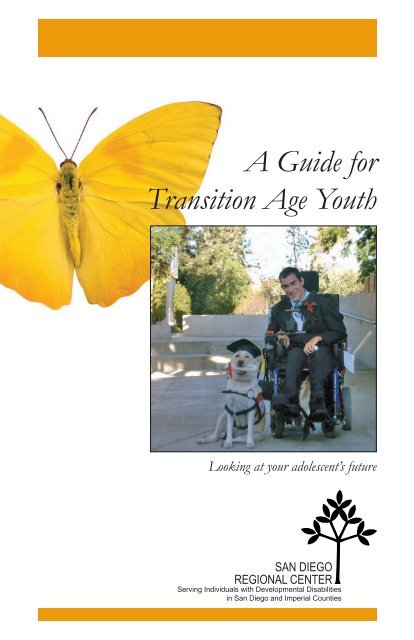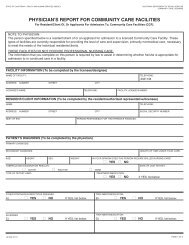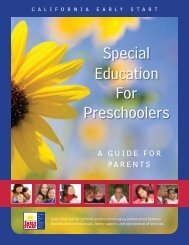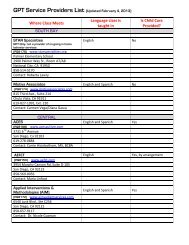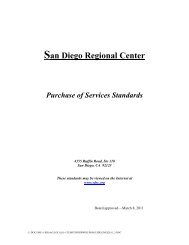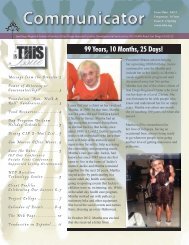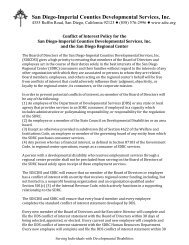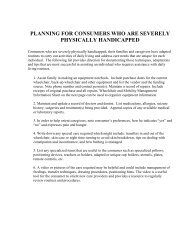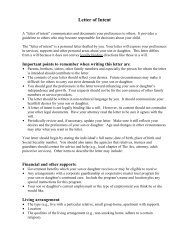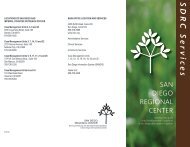A Guide for Transition Age Youth - San Diego Regional Center
A Guide for Transition Age Youth - San Diego Regional Center
A Guide for Transition Age Youth - San Diego Regional Center
You also want an ePaper? Increase the reach of your titles
YUMPU automatically turns print PDFs into web optimized ePapers that Google loves.
TABLE OF CONTENTSPageWhat will my child’s future be like?.................................................................................. 2Recognizing my child’s strengths and preferences.......................................................... 3How will we get services and supports after leaving school?.......................................... 3How my <strong>San</strong> <strong>Diego</strong> <strong>Regional</strong> <strong>Center</strong> (SDRC) service coordinator can help.................... 4How will my child make friends after leaving school?...................................................... 5How will my child find a job or something else to do during the day?.............................. 5Where will my child live as an adult?............................................................................... 6What legal and benefit issues will I need to deal with as my child gets older?................ 8A <strong>Guide</strong> <strong>for</strong> <strong>Transition</strong> <strong>Age</strong> <strong>Youth</strong>: Questionnaire........................................................... 10A <strong>Guide</strong> <strong>for</strong> <strong>Transition</strong> <strong>Age</strong> <strong>Youth</strong>–Looking at Your Adolescent’s Future 1
WHAT WILL MY CHILD’S FUTURE BE LIKE?If you are like other parents of children with developmental disabilities, you have probablywondered what your child’s life will be like when he is an adult. Parents of teenagersoften have concerns and thoughts such as:I’m worried about my child’s future. He’ll soon be an adult but he’s not like otheradults. Up until now we’ve depended a lot on the schools. What happens when he’sno longer in school?All my child’s friends have been at school with her. How will she find new friends orkeep her old friends when she no longer goes to school?What if my child wants to move out on his own? How will he find a place to live or aroommate? How will he be able to look after himself if he lives in his own place?My child’s friends are talking about getting jobs. What if she wants to get a job?How will we even know what jobs are available <strong>for</strong> her?What if my child does not want to have a job? What will I do if she doesn’t havesomething to keep her busy during the day?Who will look after my child after I die? How will he support himself when I’m nolonger here?This booklet is <strong>for</strong> all parents who have had these kinds of thoughts. In it, we answer fivequestions frequently asked by parents of adolescents:Question 1:Question 2:Question 3:Question 4:Question 5:How will my child get services and supports after leaving school?How will my child make friends after leaving school?How will my child find a job or something else to do during the day?Where will my child live as an adult?What legal and benefit issues will I need to deal with as my child getsolder?Be<strong>for</strong>e we address these five questions, take a moment to ask yourself how you willknow which of the options are right <strong>for</strong> your child. For example, once you know whatkinds of jobs or living arrangements are possible, how will you know which one will bebest? The answers to such questions lie within your child. Answers will depend upon hisstrengths and preferences. So, a first step <strong>for</strong> you and your child is to begin finding outwhat he likes or doesn’t like, what he does well and what he needs assistance with.2A <strong>Guide</strong> <strong>for</strong> <strong>Transition</strong> <strong>Age</strong> <strong>Youth</strong>–Looking at Your Adolescent’s Future
RECOGNIZING MY CHILD’S STRENGTHS AND PREFERENCESPeople are happiest when they are doing things they like and things they do well. Yourteenager is no different. Help him find greater success and happiness by identifyingthese strengths and preferences now and helping him find activities that will let him takeadvantage of them.People cannot know what they do well or what they like to do without being exposed todifferent options. Options include places to live, jobs, recreational activities, hobbies, oranything else. It is very important <strong>for</strong> you to help your child learn what options exist inthe world. This means providing opportunities <strong>for</strong> your child in the community to see howpeople live, how they work, and how they spend their time.Whenever you go out with your child, pay attention to jobs or other activities that yousee people doing. It may be especially helpful <strong>for</strong> your adolescent to see people withdisabilities who have already made the transition from school. Ask your child if he knowswhat the person is doing and what he likes or does not like about that particular activity.This will allow you to gather in<strong>for</strong>mation that you can use in the future to make decisions.In the back of this booklet is a simple <strong>for</strong>m that will help you and your child begin toidentify what he likes and what he does well. It has sections to write observations aboutyour child and to rate how much he likes different activities and places. There is also a<strong>for</strong>m you can use to record how your child reacts to things that he sees in the community.HOW WILL WE GET SERVICES AND SUPPORTS AFTER MY CHILDLEAVES SCHOOL?One of the biggest challenges of transition is finding the supports and services you needafter your child leaves the public school system. You may have wondered what’s outthere <strong>for</strong> an adult with developmental disabilities who has left school.The good news is that many supports and services already exist, and new options areopening up all the time. This is especially true now that people with disabilities are takinga more active part in the community. Many of the social and physical barriers that in thepast kept people with a disability from making full use of the community are being brokendown. The emphasis now is on giving people the support they need to live as active,involved members of the community. When your child becomes an adult, the chances arethat he will live in the community, have a job, or participate in meaningful activities duringthe day and have access to community resources just like his peers without disabilities.A <strong>Guide</strong> <strong>for</strong> <strong>Transition</strong> <strong>Age</strong> <strong>Youth</strong>–Looking at Your Adolescent’s Future 3
HOW WILL MY CHILD MAKE FRIENDS AFTER LEAVING SCHOOL?When your child leaves school, he may choose to be involved in some type of dailyactivity where he will be able to make friends, just as he did in school. He may want moreeducation or training (<strong>for</strong> example, at a community college), he may want to get a job, orhe may choose to get involved in some other kind of organized day activity. In any case,he will probably be doing it with his peers.To help prepare your child to make friends in these new settings, you can give himopportunities to practice meeting people while he is still in school. A good way to do thisis to involve him in community recreational activities. Local communities sometimesoffer social and recreational activities designed <strong>for</strong> young people with developmentaldisabilities. Sometimes other programs, such as regular youth sports leagues, can beadapted to support a boy or girl with special needs. This is particularly true if a familymember, friend, or peer without a disability is available to give the child extra support.Getting involved in social activities with peers without disabilities is a good way <strong>for</strong> youradolescent to develop behaviors that are appropriate <strong>for</strong> his age. Teenagers have a greatneed to be accepted by their peers and looking and acting like their peers is a sure roadto acceptance. If your child has opportunities to interact with peers without disabilities,he is more likely to understand the norms in behavior and dress and want to adopt them.This may make it more likely that he will be accepted by peers without disabilities. Italso makes it less likely that he will be exploited by people who would take advantage ofsomeone who appears different.Your child may also benefit from having a friend who can take him into the community orgo with him to particular activities. This friend might be a brother or sister, a neighbor ofthe same age, or a volunteer from the community. Ask your SDRC service coordinatorabout other ways that your child may find a friend.HOW WILL MY CHILD FIND A JOB OR SOMETHING ELSE TO DODURING THE DAY?More and more people with developmental disabilities are entering the job market.Employers are hiring them because they have found that people with disabilities makegood employees. They are reliable, they work hard, and they take pride in their work.Often these people may need extra support to learn a job, learn to get along with othersin the work setting, and learn related skills such as using public transportation to get tothe job. Once they’ve learned these things, they are excellent employees.A <strong>Guide</strong> <strong>for</strong> <strong>Transition</strong> <strong>Age</strong> <strong>Youth</strong>–Looking at Your Adolescent’s Future 5
Supported LivingSupported living services attempt to maximize freedom and self-determination <strong>for</strong> adultconsumers. They may live in apartments, condos, or houses in the community. Theyoften live with roommates and receive training in the skills they need to live on their own.They also receive ongoing support in those areas where it is needed. Skills training canhelp adults learn things such as cooking, cleaning, shopping, menu planning, personalhygiene and health care, money management, and use of public transportation and othercommunity resources.Independent LivingPeople may receive Independent Living Skills (ILS) services to help them live in theirown apartment, home, or other type of unlicensed setting. Such services allow them toreceive assistance from an ILS instructor. ILS services are designed to assist adults todevelop skills in areas including cooking, cleaning, budgeting, shopping, transportation,and community awareness so that the highest level of independence can be reached andmaintained.For more in<strong>for</strong>mation on different potential living settings visit the SDRC CommunityServices Department or ask your service coordinator <strong>for</strong> a copy of the brochure,“A Consumer and Family <strong>Guide</strong> to Living Options.”A Final NoteParents and their children often tell us that one of the most difficult things about transition<strong>for</strong> young adults is leaving friends that they may have had <strong>for</strong> many years. This isespecially true when students leave school. Often they express sadness or signs of losswhen they are no longer surrounded by the school structure they have enjoyed since agethree. To help lessen the impact of this type of loss, you may want to limit the number ofchanges that your son or daughter makes at any one time. For example, if he or she ismoving from school to a day activity or supported employment, you may want to delayany change in his or her residence until he or she is acclimated to the new environmentand has made friends there. Making changes gradually will help ensure that your son ordaughter always has a circle of support made up of people he or she knows, trusts, andcan talk to.A <strong>Guide</strong> <strong>for</strong> <strong>Transition</strong> <strong>Age</strong> <strong>Youth</strong>–Looking at Your Adolescent’s Future 7
WHAT LEGAL AND BENEFIT ISSUES WILL I NEED TO DEAL WITH ASMY CHILD GETS OLDER?When they turn 18, individuals with developmental disabilities gain the same rights andresponsibilities as other adults. Many of these adults routinely make decisions on theirown behalf with guidance from their family, service coordinator, advocate, or trustedfriends. We at the <strong>San</strong> <strong>Diego</strong> <strong>Regional</strong> <strong>Center</strong> encourage families to involve their sons ordaughters in decision-making, allowing them to practice self-determination to the extentthey are able.Some adults with developmental disabilities have limited ability to make in<strong>for</strong>meddecisions. Often, families tell us that their biggest concern is that their son or daughterwill be unable to provide in<strong>for</strong>med consent <strong>for</strong> medical care. For families whohave concerns about their child’s ability to make decisions, there are several legalarrangements that allow them or a third party to retain responsibility <strong>for</strong> some aspects oftheir child’s life. Arrangements that families most often use are limited conservatorships,trusts, and powers of attorney.Limited ConservatorshipA conservatorship takes away some of an adult’s basic rights and gives those rightsto another individual, often either a family member or a professional conservator. Aconservator may make decisions about things such as the conserved person’s healthcare, living arrangement, and finances. A conservatorship can only be established ina court of law, and it is the court that decides what the conservator will be allowed tomake decisions about. Because it takes away a person’s basic rights, a conservatorshipshould be used only when a less restrictive arrangement does not give the person with adevelopmental disability enough protection.TrustA trust is a legal arrangement that gives an independent person, called a trustee, controlof a disabled person’s assets such as money and property. A trustee may be a relative,family friend, or independent agent. He or she is responsible <strong>for</strong> making sure the assetsare handled responsibly and in the best interests of the person with a disability.A trust is particularly useful if parents or other relatives wish to leave a person with adisability money or other things of value in their will. The assets are placed under thecontrol of the trustee, who gives payments to the person with a disability at regularperiods. The payments can be adjusted so they provide financial support over theindividual’s lifetime. They may also be limited so they do not affect the person’sgovernment benefits.8A <strong>Guide</strong> <strong>for</strong> <strong>Transition</strong> <strong>Age</strong> <strong>Youth</strong>–Looking at Your Adolescent’s Future
Social SecurityOnce a person turns 18 years of age, he may be eligible <strong>for</strong> Supplemental SecurityIncome (SSI) and Medi-Cal. Whether or not an adult qualifies <strong>for</strong> these programsdepends on two things: his personal income and the severity of his disability. When yourson or daughter turns 18 (if you have not done so already), you should contact your localSocial Security Office to begin the process of applying <strong>for</strong> SSI and Medi-Cal. Be sure tolet them know that your son’s or daughter’s records are available from the <strong>San</strong> <strong>Diego</strong><strong>Regional</strong> <strong>Center</strong>. With your signed consent, we will <strong>for</strong>ward these records to the SocialSecurity Office so they can be used in determining eligibility.Until recently, people receiving SSI and Medi-Cal who went to work risked losing oneor both of these benefits once they began to get a paycheck. The government recentlychanged this to give people more of an incentive to work. Under the new rules, a personmay earn $85 in a month and still receive his full SSI check. For every two dollars aperson earns over $85, the government deducts $1 from the person’s SSI check. Theperson remains eligible <strong>for</strong> Medi-Cal to pay <strong>for</strong> doctor visits, hospital care, and medicineseven when he earns too much money to receive cash SSI benefits. This is true as longas the person’s savings do not go over a certain level (currently $2,000). People workingunder these new rules may go back to receiving their regular SSI payments if they stopworking or if they don’t earn enough income.In-Home Supportive ServicesThe In-Home Supportive Services (IHSS) program, operated by the Cali<strong>for</strong>niaDepartment of Social Services, helps provide care and supervision <strong>for</strong> people withdisabilities in their homes. It is intended <strong>for</strong> people who need care to remain safely intheir own homes. Your son or daughter could receive IHSS support while living with youor while living on his or her own in an apartment, condo, or house.To qualify <strong>for</strong> IHSS, your son or daughter must be a lawful resident of Cali<strong>for</strong>nia with lowincome and limited resources (such as would make him or her eligible <strong>for</strong> SSI) and mustneed care to remain safely in his or her home. Minor children may also be eligible toreceive IHSS.You can get more in<strong>for</strong>mation on the IHSS program by asking your SDRC servicecoordinator <strong>for</strong> contact in<strong>for</strong>mation to your local Social Services office.A <strong>Guide</strong> <strong>for</strong> <strong>Transition</strong> <strong>Age</strong> <strong>Youth</strong>–Looking at Your Adolescent’s Future 9
LOOKING AT MY CHILDA GUIDE FOR TRANSITION AGE YOUTHQUESTIONNAIRE1. My child’s greatest strength is:______________________________________________________________________________________________________________________________________2. My child truly loves to:______________________________________________________________________________________________________________________________________3. My child tries to avoid:______________________________________________________________________________________________________________________________________4. My child’s favorite class(es) and hobbies is(are):______________________________________________________________________________________________________________________________________5. My child’s chores at home include:______________________________________________________________________________________________________________________________________Circle the number that best describes how true each statement is:My child:AlwaysTrueOftenTruePrefers to be outdoors 1 2 3Prefers to work as part of a group 1 2 3Prefers to work with people 1 2 3Prefers to work with animals 1 2 3Prefers to work with plants 1 2 3Prefers to work with things 1 2 3Prefers to keep neat and clean 1 2 3Repeats a task without losing interest 1 2 3Enjoys learning new things 1 2 3NotTrue(Any other strong preference)_________________________________________________________________________________________________________________________________________________________________________________________________________10A <strong>Guide</strong> <strong>for</strong> <strong>Transition</strong> <strong>Age</strong> <strong>Youth</strong>–Looking at Your Adolescent’s Future
WORK AND LEISURE OPTIONSComplete the following items <strong>for</strong> each type of work you discuss with your child:Kind of job:______________________________________________________________________________________________________________________________________Understanding of job duties:______________________________________________________________________________________________________________________________________Likes about this job:______________________________________________________________________________________________________________________________________Doesn’t like about this job:______________________________________________________________________________________________________________________________________Complete the following items <strong>for</strong> each social, leisure, or creative activity you explore withyour child:Social, leisure or creative activity:______________________________________________________________________________________________________________________________________Previous experience with this activity:______________________________________________________________________________________________________________________________________Likes about this activity:______________________________________________________________________________________________________________________________________Doesn’t like about this activity:______________________________________________________________________________________________________________________________________A <strong>Guide</strong> <strong>for</strong> <strong>Transition</strong> <strong>Age</strong> <strong>Youth</strong>–Looking at Your Adolescent’s Future 11
NOTES________________________________________________________________________________________________________________________________________________________________________________________________________________________________________________________________________________________________________________________________________________________________________________________________________________________________________________________________________________________________________________________________________________________________________________________________________________________________________________________________________________________________________________________________________________________________________________________________________________________________________________________________________________________________________________________________________________________________________________________________________________________________________________________________________________________________________________________________________________________________________________________________________________________________________________________________________________________________________________________________________________________________________________________________________________________________________________________________________________________________________________________________________________________________________________________________________________________________________________________________________________________________________________________________________________________________________12A <strong>Guide</strong> <strong>for</strong> <strong>Transition</strong> <strong>Age</strong> <strong>Youth</strong>–Looking at Your Adolescent’s Future
Child Adolescent Adult♦♦♦Text adapted with permission from Harbor <strong>Regional</strong> <strong>Center</strong>.♦♦♦A <strong>Guide</strong> <strong>for</strong> <strong>Transition</strong> <strong>Age</strong> <strong>Youth</strong>–Looking at Your Adolescent’s Future 13
SAN DIEGOREGIONAL CENTERServing Individuals with Developmental Disabilitiesin <strong>San</strong> <strong>Diego</strong> and Imperial Counties4355 Ruffin Road, Suite 200, <strong>San</strong> <strong>Diego</strong>, CA 92123-1648858-576-2996 • Fax—858-576-2873www.sdrc.org9/2010


